
Welcome, Sister Death
On the Remarkable Departures of Illumined Beings
by Ron Boyer
The Laughing Man magazine, Vol 2. no. 3, 1981.
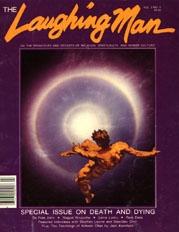
And Death is our sister, we
praise Thee for Death, Who releases the soul to the
light of Thy gaze;
And dying we cry with the
last of our breath
Our thanks and our praise.
-the dying words of St. Francis of
Assisi
E arly in this century
there lived a great yogi named Zippruana. He was widely
known and respected for his miraculous yogic powers that
included an uncanny capacity to see into the past and
future; he used to tell anxious schoolboys whether they
would pass upcoming exams or not. Zippruana also had a habit
of sitting completely naked on piles of garbage and feces.
But perhaps the most amusing thing about his peculiar habits
was the fact that, no matter how filthy his environment
became, neither dust nor dirt would stick to his body when
he arose to leave. In addition, the air surrounding him as
he sat in the garbage was permeated with the sweetest of
odors. Zippruana’s death was as unconventional as his life
had been:
“When his final time came, a lot of people who loved
him were around. One of them was an old teacher, a woman. He
went to her home. He said, ‘Massage my body with ‘oil and
put some hot water on, I want to have a bath.’ She massaged
his body and gave him a bath and then gave him some milk.
After he had drunk the milk he said, ‘Now Zippruana is
leaving, and you can cry as much as you want to.’ And he
left his body. ,1
Zippruana’s biographer, the contemporary yogi Baba
Muktananda, goes on to conclude: “That is how a great
yogi leaves his body.”
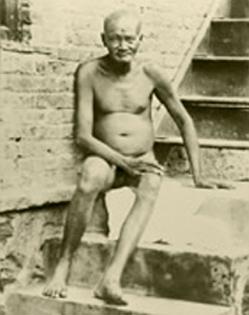
Zippruana
There is a lesson to be learned in the example of
Zippruana’s death and the deaths of all “great souls” like
him. The religious traditions of the world are filled with
extraordinary deaths of men and women of uncommon spiritual
maturity who face their own demise in a disposition of
profound equanimity and self-surrender into the
transcendental Reality, which is their (and our) very
Nature. Such ones die in a remarkable way, having already
died in Truth. Their intimate knowledge of the “great
Person” is such that their own lives and deaths are revealed
as utterly insignificant bits of the Divine Play.
Curious and “playful” phenomena often accompany the
deaths of great yogis, saints, mystics, and sages of the
highest types. In some instances, as with Zippruana, the
most “remarkable” thing about it is the simplicity and ease
of departure, which suggests an uncommon capacity for
self-surrender and ecstatic acceptance of death. Like St.
Francis of Assisi, he seemed so familiar and even welcoming
in his attitude toward death that it becomes a simple yet
elegant form of praise of the Divine Life. In other
instances this ecstatic acceptance is taken to extremes in
the form of outrageous, transcendental humor regarding one’s
imminent death. In other traditional accounts one finds
evidence of miraculous spiritual powers that mysteriously
“transfigure” the adept’s body-creating extreme longevity,
lifelike preservation of the corpse, or forms of spontaneous
bodily translation in which the body simply dissolves into
thin air. Such strange phenomena seem to defy our known laws
of science and medicine. Finally, there are the less
outwardly spectacular deaths of the greatest sages, whose
final moments are a living testimony to their own
realization of the ultimate identity of life and death, and
an invitation to all of us to engage spiritual practice with
great faith and perseverance and so realize the immortal
Truth in our own lifetimes.
The Humorous Acceptance of Death
The disposition of ecstatic and often humorous acceptance
of death is universal among the most spiritually illumined
personalities. The spiritual process alive in such beings
involves increasingly subtler forms of self-transcendence in
which they become more and more perfectly “dead to
themselves.” They are familiar with the process of death
even as they live and often to the point of having intuitive
foreknowledge of the precise time and manner of their own
demise. This foreknowledge is often accompanied by a
profound capacity to “laugh at death” as a final amusement
and paradoxical instruction to their disciples. Although
this freedom is by no means limited to the Zen Buddhist
tradition, there are abundant stories of Zen adepts who use
their own death in this manner. Their deaths were
characterized by an uncommon gracefulness and humor, often
immortalized in “death poems” written or spoken just before
their death. The stories that follow reflect this manner of
dying among the great ones.
When the great Taoist master Chuang-tze’s beloved wife
died, he accepted her departure with remarkable equanimity,
even joy. When guests arrived for her funeral rites, they
found the sage sitting on the front lawn singing joyfully
and drumming on an overturned bowl hardly the solemn
ceremony they had expected. An offended guest scolded him
for his eccentric improvisation; Chuang-tze replied simply
that to “break in upon her rest with the noise of
lamentation would be to show I knew nothing of nature’s
Sovereign Law. At first I felt saddened by her death. Then I
realized that when born she appeared out of nothing and now
she has simply returned to that same nothing.”2
Later, as Chuang-tze’s own time came, he instructed his
disciples to abandon their plans for an elaborate
funeral-the earth and stars would serve him well as a
coffin. When they protested that his body would be
desecrated by scavengers, Chuang-tze replied: “Above the
ground my flesh will feed the crows and kites, below the
ground, the ants and cricket-moles. Why rob one to feed the
other?” 3
shining as the Sun beyond
darkness.
Only upon knowing Him
one supercedes death. There is no other path for
one to follow.
-Yajur-Veda (Ch. 31, vs. 18)
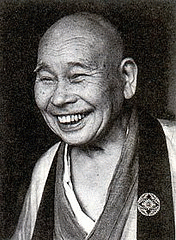
Gempo Yamamoto (1866—1961) was a
Japanese Rinzai master who served as abbot of both Shoin-ji
and Ryutaku-ji
At the age of ninety-six Zen master Yamamoto decided that
he had outlived his usefulness, for he could no longer earn
his keep by working in the fields or teaching students. He
decided to simply stop eating and die. His disciples urged
him to reconsider, and finally they convinced the old man to
eat with this argument:
“If you die now [January] when it is so cold,
everybody will be uncomfortable at your funeral and you will
be an even greater nuisance, so please
eat.”4
The compassionate old master resumed eating until warm
weather came again and died shortly thereafter.
A contemporary Zen master, Roshi Taji, was dying. One of
his senior disciples remembered that the master was fond of
a certain kind of cake and desperately searched for hours
through the pastry shops of Tokyo to find it. Returning, he
offered the cake to Taji, who smiled and accepted it. But
even as he began to munch, he grew visibly weaker, and his
disciples leaned over him to ask him if he had any final
words to them. “Yes,” whispered the master, and they eagerly
leaned close to hear his final words of wisdom. “Please tell
us!” they said. “My, but this cake is delicious!” said Roshi
Taji, and with that he died.5
The great Zen master Etsugen told his disciples one day
that he had decided to die in a week on the day that would
commemorate the Buddha’s enlighten-‘
When the day arrived, he gathered his disciples together,
and shortly before closing his eyes in death Etsugen
composed the following death poem:
“Shakyamuni [Buddha] descended the
mountain.
I went up.
In my teaching, I guess I’ve always been
Something of a maverick.
And now I’m off to hell-yo, ho!
The inquisitiveness of men is pure
folly.”6

Jalal al-Din Rumi
According to legend the Sufi poet Jalal al-Din Rumi’s
death was preceded by a mysterious rumbling and shaking of
the earth that frightened the residents of the village where
Rumi lived. During the several days of earthquakes Rumi
himself became very weak and exhausted. Rumi consoled his
friends with poetry and told them not to fear for their own
lives. “The earth is hungry. Soon, it will get a fat morsel
and then give rest.”7 Rumi died peacefully at
sunset, and the earth rested again.
Sarmad was a great poet, saint, and finally, martyr, who
lived during the reign of the Mogul Emperor, Aurangzeb, in
India. His teaching transcended the limitations of religious
dogma, and for this reason he became a venerated master of
the Sikh religion as well as a beloved saint of the Islamic
sufis (he was born a Jew). But he ran afoul of Aurangzeb’s
high priest by publicly proclaiming his ecstatic union with
the Divine by shouting the phrase, “Ana-ulHuq!” (“I am God”)
wherever he went. He was arrested and tried for this heresy
and condemned to immediate death by beheading if he did not
repent. When Sarmad replied, “Ana-ul-Huq!” he was swiftly
executed on the spot. At this point Sarmad’s biographers
tell us that the headless body stood up and grasped the
severed head, lifting it high into the air. Facing the
assembly, the head of Sarmad opened its mouth and shouted to
the crowd, “Ana-ul-Huq! Ana-ulHuq!”8
Death and the Regenerated Body
Extraordinary spiritual
phenomena are often associated with the lives of the great
adepts. Many demonstrate miraculous healing powers, psychic
abilities, or occult powers over nature. In some cases a
visible radiance shines from the body clearly recognizable
by others privileged enough to bear witness. And in rare
cases these spiritual processes lead to extreme longevity in
the adept. Consider the numerous stories of Hindu and Taoist
Immortals or the biblical accounts of the Hebrew Patriarchs
who lived for hundreds and hundreds of years. Even in the
twentieth century there have been a number of documented
cases of advanced yogis who lived unusually long and
illustrious lives. The Shivapuri Baba, who died in 1962,
lived 137 years. During his long life he circumambulated the
entire earth, meeting and counseling many dignitaries and
heads of state in the process.9
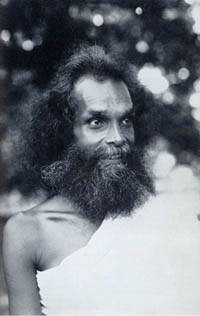
The Shivapuri Baba, age 112 years
In recent times photographs have been taken of a
mysterious and little-known Indian saint, Hariakhan Baba,
who has appeared (often in the form of visions to advanced
yogis) recurrently throughout India over the past several
thousand years.10

Hariakhan Baba
It is also not uncommon for such highly evolved
individuals to have comparably miraculous phenomena
associated with their deaths. A fairly common further
development of these “transfiguring” processes results in
the phenomena of regeneration and spontaneous preservation
of the adept’s corpse.” It is widely acknowledged in the
Hindu, Tibetan Buddhist, and Catholic mystical traditions
that highly evolved saints often show no visible signs of
bodily decay for some time after their deaths-occasionally
for hundreds of years! During this period the body remains
soft and pliable, like that of a young child, and often with
a dazzlingly radiant complexion-whitened skin with a
rosiness in the cheeks more vibrant than while the person
lived.12
Within the Hindu tradition there are relatively recent
accounts of extreme longevity, as in the case of the
Trailinga Swami (1640-1887).
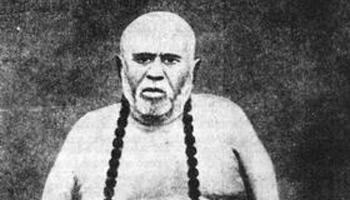
The Trailinga Swami was a naked yogi known throughout
India for his miraculous powers and longevity. A latecomer
to spiritual life, he was initiated by his guru at the age
of 78 and thereafter began a long pilgrimage throughout
India, during which time it is said that he showed no signs
of aging due to his extreme austerities. Finally, he settled
down in Benares, where he lived for the next 150 years as a
renunciate. During this time he never spoke, rarely ate
food, and wandered on the banks of the Ganges (or floated
stationary in midstream). Sri Ramakrishna, another Indian
saint, met Trailinga Swami shortly before his death in 1887
at the age of 247 years, calling him a true incarnation of
Lord Siva himself.
More recently the Hindu ascetic Tapaswiji Maharaj
(1770-1955) died at the age of 185 years. In 1940 Life
magazine ran an article on Tapaswiji calling him the
“miracle man of India.” The article called attention to the
fact that he had undergone a remarkable process of
rejuvenation called kayo kalpa, “cleansing the body,”
through which Tapaswiji dramatically reversed the aging
process on three separate occasions during his life. On the
last occasion he is reported to have spent one year
underground, emerging in the physical condition of a
30-year-old man, although he was well over 100 years old at
the time. He attributed the success of the treatment
primarily to ecstatic absorption in Lord Krishna,
secondarily to his own yogic proficiency, and only
peripherally to ingestion of the herbs prescribed by the
treatment itself.
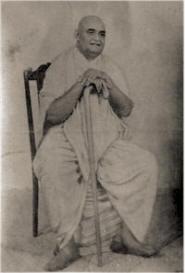
Tapaswiji Maharaj
A classic example of super-regeneration that combines
both a reversal of aging processes and spontaneous
preservation of the corpse is evident in the death of the
founder of the Tibetan Buddhist lineage of the Yellow Hats
(that is, Gelugpa Sect), Tsong-kha-pa, in the early
fourteenth century.
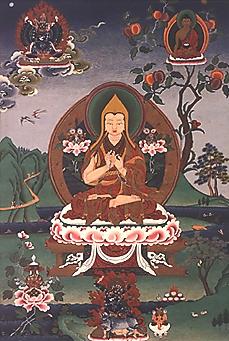
Lama Je Tsongkhapa (1357-1419)
One day Tsong-kha-pa announced that he would soon die.
Then he began a complicated process of meditation lasting
for several days, in which, in the presence of hundreds of
disciples, Tsong-kha-pa first ceased breathing and then
transformed his old body into that of a vibrant youth.
Rainbows reportedly filled the room where his body sat in
death-samadhi. Soon thereafter his disciples encased the
remains in a special shrine room at the monastery, where
they remained in the regenerated condition for 500 years
until the Chinese Communists invaded Tibet in the 1950s. The
Chinese invaders were apparently startled to find
Tsong-kha-pa’s body in such perfect condition-still warm to
the touch, the nails and hair still growing, and the body
that of a teenager. Presumably, say his biographers, the
Chinese could not tolerate the miraculous evidence of the
power of spiritual practice and burned the body along with
destroying the monastery where Tsong-kha-pa sat in
state.13

St Teresa of Avila
The Catholic mystic St. Teresa of Avila stands out as one
of the most unusual examples of bodily transfiguration and
regeneration yet recorded. In Teresa’s case the greatest
healing miracles were accomplished with relics (hairs,
teeth, fingers, etc.) taken from her body after death. It is
said that Teresa’s body showed no signs of decay for
hundreds of years and that, quite to the contrary, her
corpse emitted a strange, sweet fragrance of fresh flowers.
On one occasion two greedy priests broke into Teresa’s crypt
to steal parts of her body (which they could sell at a
handsome price for their miraculous healing powers), but the
minute the crypt was open the strong fragrance permeated the
entire convent. The nuns gathered upstairs at Mass knew the
crypt had been entered and rushed to protect the corpse,
catching the burglars in the act.
The thirteenth-century yogi-saint, Jnaneshwar, had a tomb
built for him by his devotees. He entered it promptly upon
completion, leaving instructions that it was to be sealed
tightly and never entered. Nearly three hundred years later
another saint, Ecknath, entered the tomb. He emerged to
report that the body of Jnaneshwar was still warm and
apparently living. Ecknath explained that the body had been
miraculously preserved, still sitting in full-lotus
position, through a permanent yogic activity of the
life-force in the body.
Unfortunately, much of the evidence of such miraculous
preservation has gradually disappeared through the
centuries-especially due to graverobbers and vandals seeking
relics. But in the case of the contemporary yogi Paramahansa
Yogananda we have an extremely well-documented example of
bodily regeneration. Yogananda died in Hollywood in 1952,
and his body was taken to Forest Lawn Cemetery to be buried.
The director of the Forest Lawn Mortuary mailed a notarized
letter to Yogananda’s fellowship documenting the remarkable
preservation of the yogi’s corpse:
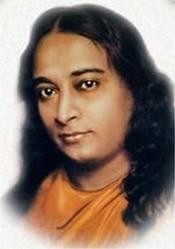
Paramahansa Yogananda
“The absence of any visual signs of decay in the dead
body of Paramahansa Yogananda offers the most extraordinary
case in’ our experience. . No physical disintegration was
visible in his body even twenty days after death. . . . No
indication of mold was visible on his skin, and no visible
(drying up] . . . took place in the bodily tissues. This
state of perfect preservation of a body is, so far as we
know from mortuary annals, an unparalleled one. . . . At the
time of receiving Yogananda’s body, the Mortuary personnel
expected to observe, through the glass lid of the casket,
the usual progressive signs of bodily decay. Our
astonishment increased as day followed day without bringing
any visible change in the body under observation.
Yogananda’s body was apparently in a phenomenal state of
immutability. . No odor of decay emanated from his body at
any time. . . . For these reasons we state again that the
case of Paramahansa Yogananda is unique in our experience.”
14
Spontaneous Translation of the Body
into Light
On rare occasions the
processes of bodily transfiguration lead to a more
extraordinary phenomenon of actual spontaneous absorption or
divine “translation” of the adept’s body into light. There
are numerous reports (only a few fully documented) of great
adepts who have, like Sri Chaitanya (the spiritual figure
whose teachings inspired the founding of the Hare Krishna
movement), literally vanished into thin air at the height of
ecstatic trance. One moment they are there, and the next
moment they are gone.
Generally, these dissolution’s of the body are observed
to take place through the sudden appearance of a
supernatural light into which the adept is uplifted in a
transfigured state and absorbed.
In the Tibetan Buddhist tradition, for example, the
greatest yogis commonly transform their bodies into
“rainbows” at the moment of death; generally this “rainbow
body” is attained in the presence of hundreds of disciples.
In whatever tradition, this phenomena of bodily translation
is one of the most remarkable of all spiritual
manifestations-and among the most humorous possible passages
out of this world.
The nineteenth-century Tamil saint Ramalingam may have
been an example of bodily translation, although no one
actually witnessed his disappearance. Ramalingam had,
dedicated his entire life to the pursuit of an imperishable,
“golden-hued form” – a transfigured, immortal existence he
taught to be the birthright of all beings. But in the end he
became discouraged at the mediocre response of his disciples
and suddenly announced his coming departure from this
world:

Ramalingam
“Friends, I have opened a shop but there was none to
purchase; so I have closed it. I will not be visible to your
eyes for a certain period, although I will be universally
present in the world. My imperishable body will enter into
the bodies of all living beings. I will reappear again at
the proper time after having preached my message in other
countries. Until then, worship God in the form of light and
attain salvation.”15
Then Ramalingam entered his room and ordered it shut and
sealed from the outside. He instructed disciples not to
enter as they would be disappointed at his invisibility.
After a while the anxious disciples entered the room and
found it completely sealed on the inside as well. But
Ramalingam was nowhere to be found.
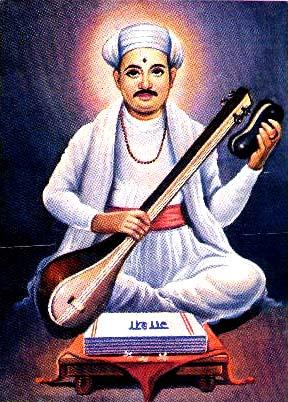
Tukaram
Tukaram was a great saint and devotee of Krishna, who
raised the dead and fed the multitudes. Thousands of
worshippers from distant villages journeyed to join Tukaram
during his ecstatic religious celebrations. Before his
death, in 1648, Tukaram exhibited dramatic signs of bodily
transfiguration: on one occasion, when the gathering became
so absorbed in devotional singing that the unattended oil
lamps went out and plunged the celebrants into darkness,
Tukaram’s body glowed with a supernatural brilliance that
filled the room with light. Soon thereafter he received
foreknowledge of his pending death in a vision in which he
was instructed to gather his devotees together. Tukaram sang
late into the night, “I have seen my own death with my own
eye. It was incomparably holy!” At the peak of their ecstasy
a blazing pillar of light descended on Tukaram, temporarily
blinding his followers. When they opened their eyes, he was
gone.
The great jnani, sage,” Sri Ramana Maharshi was fond of
telling his own disciples of an even rarer account of bodily
translation. There was a medieval Indian saint, Thirujnana
Sambandar, who at the young age of sixteen submitted to his
parents’ wishes that he fulfill the customary obligations of
ritual marriage. Sri Ramana relates what then occurred:
“He got married in his sixteenth year. The bride and
the bridegroom went to . . , the local temple soon after the
marriage ceremonies were over. A large party went with them.
When they reached the temple, the place was a blaze of
light. Jnanasambandar told the people to enter the
passageway. They did so. He himself went round the light
with his young wife, carne to the passage grid entered it as
the others had done earlier. The light vanished leaving no
trace of those who entered it. The temple came into view as
usual. Such was the brief but very eventful life of the
sage.”
Only the Truth Remains
Forever
glorious about the Maharshi’s death: he did not
live to be extraordinarily old, nor was his body
regenerated at death, nor did he vanish in a blaze
of supernatural glory. He died from cancer, in
great pain.
Such examples of remarkable
death are not to be interpreted merely as fascinating ways
of dying, but as the extraordinary effects of a profound
spiritual process to which such great beings have given up
their whole lives. Furthermore, these exalted states of
bodily regeneration, transfiguration, and translation are
not to be confused with a less visible but more fundamental
spiritual process underlying the remarkable deaths of yogis,
mystics, and saints of the highest type. That primary
process is one of perfect self-sacrifice in which the adept
matures into absolute transcendence of the independent
experiential point of view. In this sense the “dissolution
of self” is more significant than the exalted “ascension of
self.”17 Such ultimate self transcendence,
evidenced in the greatest sages and “avatars,” is a perfect
realization of our ultimate identity prior to life and
death. In these adepts their ecstasy transcends all
limitations in a paradoxical wisdom that goes beyond both
self annihilation and self-preservation.,18 For
this reason the Vedic texts state that one who realizes the
Supreme Being becomes the Supreme Being and in this most
profound liberation becomes truly immortal, “neither living
nor dying.”19 “Free from joy and sorrow, he
neither dies nor does he live,”20 A famous Zen
Buddhist koan elegantly summarizes this paradoxical
understanding of the Truth that transcends life and
death:
“Dogo went with his disciple Zengen to a certain house
to offer condolences for someone’s death. Zengen rapped on
the coffin and said to Dogo, ‘Is he alive or dead?’ Dogo
replied, ‘I do not say he is alive; I do not say he is
dead.’ Zengen then asked, “Why don’t you tell me (one way or
the other)?” Dogo answered, ‘I will not say! I will not
say!’ On their way hack to the temple, Zengen said, ‘Master!
Do tell me! If you don’t I’ll strike you down.’ Dogo
replied, ‘Strike me if you like but you won’t get a word out
of me.’ Zengen thereupon struck him, Afterwards, when Dogo
was dead, Zengen went to Sekiso (another of his disciples),
and told him what had happened. Sekiso said, ‘I do not say
he was alive, I do not say he was dead.’ Zengen asked, ‘Why
don’t you tell me?’ Sekiso said, ‘I will not say! I will not
say!’ Zengen suddenly realized the truth.” 21
The death in 1950 of Sri Ramana Maharshi is probably the
best modern example of the passing on of such a highly
evolved adept. There was nothing glorious about the
Maharshi’s death: he did not live to be extraordinarily old,
nor was his body regenerated at death, nor did he vanish in
a blaze of supernatural glory. He died from cancer, in great
pain. On the morning of his death Sri Ramana refused his
pain medicine, saying that everything would be all right in
a short time. At sunset he asked attendants to sit him up on
his couch, and he waved the doctors away:
“Unexpectedly a group of devotees sitting on the veranda
outside the hall began singing Arunachala-Siva’ [his
favorite song]. On hearing it, Sri Bhagavan’s eyes
opened and shone, He gave a brief smile of indescribable
tenderness. From the outer edges of his eyes tears of bliss
rolled down. One more deep breath, and no
more.22
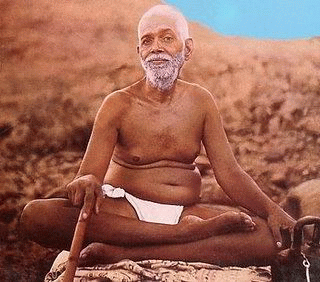
Sri Ramana Maharshi
Shortly before his death Sri Ramana had clarified
in his own way the paradoxical realization of Eternal Life,
the perfect and immortal Truth transcending life and death:
“They say that I am dying, but I am not going away. Where
could I go? I am here.”23
According to legend the Buddha instructed his closest
disciple, Ananda, to prepare a couch for him as he would be
entering nirvana before the night was over. The Buddha lay
on his side, resting his head in his hand, and spoke his
final instructions to disciples gathered about him who were
weeping in homage. He enjoined them for the last time to
realize liberation from “the vast and endless suffering” of
unenlightened existence, the endless wheel of birth and
death, and asked them not to weep for him, for “in the hour
of joy it is not proper to grieve.” Then he continued to
speak:
“It is indeed a fact that salvation cannot come from
the mere sight of me. It demands strenuous efforts in the
practice of yoga. But if someone has thoroughly understood
this my Dharma, then he is released from the net of
suffering, even though he never cast his eyes on
me.”24
One last time the Buddha urged his disciples to persevere
in the practice of virtue and mindfulness, and in so doing
realize the paradoxical liberation into Eternal Life that is
the final fruit of enlightenment for themselves. “Only the
truth will remain forever,” he said, “so work out your
salvation with diligence.”25 Then the Buddha
entered into four successively deeper samadhis, “and passing
out of the last stage of rapture he immediately
expired.”26
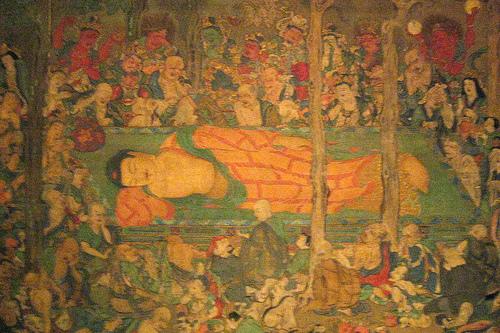
Death of the Buddha
Footnotes:
1. Getting Rid of What You Haven’t Got: Talks and
Conversations with Sri Gurudev Baba Muktananda (Albany,
Calif.: WordPress, 1974), p. 36.
2. J Head and G Cranzton (Ed,.), Reincarnation, The
Phoenix Fire Mystery (N.Y.: Warner Books, 1977), p. 111.
3. Roshi Philip Kapleau (Ed.), The Wheel of Death (N.Y.:
Harper & Row, 1971), pp.70-71.
4. Ibid., p. 68.
5. Ibid., p. 68.
6. Ibid., p. 69
7. Anne Marie Schimmel, The Triumphal Sun: The She, ii, x
the Work; of Ielal al-Din Rumi (London: Fine Books, 1978”,
p. 12
8. I. A. Erekiel, Sarnial: Jewish Saint of India (Punjab,
India: Radha Soami Satsang Beas, 1966), pp 27-.29
9. The Life and teachings of Govindananda, the Shivapuri
Baba, are presented in John G. Bennett’s Long Pilgrimage:
The Life and Teachings of The Shivapuri Baba (London:
Turnstone Books, 1975).
10. Reportedly one of the legendary Hindu Immortals,
Hariakhan Baba (Babaji) is a spiritual figure who has
mysteriously appeared over the centuries to thousands of
devotees. Recently, Babaji has played a significant role in
the spiritual lives of two well-known modern yogis, Hari
Dass Baba and Paramahansa Yogananda. For more information
read Paramahansa Yogananda’s Autobiography of a Yogi (Los
Angeles, Calif.: Self-Realization Fellowship Publishers,
1977) and Baba Hari Dass’ Hariakhan Baba: Known and Unknown
(Davis, Calif.: Sri Rama Foundation, 1975).
11. All of the individuals presented in this essay who
exhibited extraordinary phenomena at death, such as bodily
regeneration of the corpse or spontaneous translation into
light, are known to have demonstrated remarkable occult and
spiritual powers during their lives as well. Da Free John
has pointed out that the process of “transfiguration” of the
body that frequently occurs in the lives of the greatest
yogis, mystics, and saints may also be accompanied by
phenomena of “super-regeneration” and bodily “translation”
of the individuals at death. For a more detailed description
of these phenomena and their relation to one another read
The Enlightenment of the Whole Body (Middletown, Calif.: The
Dawn Horse Press, 1978), pp. 534-5.
12. In the Tibetan tradition this “whiteness” of
complexion is seen as a most auspicious sign in the
regenerated corpse of an advanced practitioner. The
qualities described here are quite common, regardless of the
particular tradition to which the adept belongs. For
example, the biographer of St. Francis of Assisi, Celano,
noted that the deceased saint’s facial skin became more
pliable and soft, like a newborn’, and that his regularly
“dark complexion” shone with a dazzling “whiteness” for
several days after his death.
13. The Third Dalai Lama, Essence of Refined Gold
(Dharamsala, India: Library of Tibetan Works and Archives),
pp. 12-13.
14. Autobiography of a Yogi, p.575.
15. T. Dayananda Francis, Ramalinga Swarmy (Bangalore,
India: The Christian Institute for the Study of Religion and
Society, 1972), p.20.
16. Talks with Sri Ramana Maharshi ‘Vols. 1-111:
(Tiruvannamalai, S India: Sri Ramanasramam, 1072), p.510
17. Da Free John, The Enlightenment of the Whole Body, p.
538.
18. Ibid., p. 534.
10 Mundaka Upanishad 3 29
20 Astavakra Gita 18 83.
21 The Zen koan is entitled “Teaching of the Identity of
Life and Death” and is quoted in R. H. Blythe’s Zen in
English Literature (Tokyo: Hokuseido Press. 1048), p.340
22. The Mahanirvana of Bhagavan Sri Ramana
(Tiruvannamalai, S India: Sri Ramanasramam, 10521, p. 8.
23. Arthur Osborne (Ed ), Ramana Maharshi and The Path of
Self-Knowledge (N.Y.: Samuel Weiser, 1973), p.185. Sri
Ramana’s statement bears a striking similarity to the
promises of many great adepts that they would remain
transcendentally present, even as the Divine Being is
already present, after their deaths. For example, the great
Zen master Ikkyu says in his death verse: “I shan’t die, I
shan’t go anywhere, I’ll he here; But don’t ask me anything,
I shan’t answer” (The Wheel of Death, p. 63) Da Free John
notes that “the death of the Perfect Devotee is not truly a
death The usual changes that manifest beings endure at death
are Outshined by the Radiance of this Ecstasy. The Perfect
Devotee simply persists in the Bliss into which he entered
in the final moments of his manifest or born existence. He
does not notice the bodymind change or pass away – He has
already gone beyond all change and all noticing of change.
It is simply that the Intensity of Bliss is magnified to the
degree of Infinity. The body-mind ceases to he present to
mediate and reflect the Glory of the Self” (The
Enlightenment of the Whole Body, p. 539)
24. The Wheel of Death, pp. 74-75
25. Quoted in John White’s Practical Guide to Death and
Dying (Wheaton, Illinois: The Theosophical Publishing House,
1980), p.89.
26 Quoted in Joseph L Henderson and Maude Oakes’s Wisdom
o/ the Serpent The Myths of Death, Rebirth, and Resurrection
(N Y.: George Braziller, 1063), p.217.